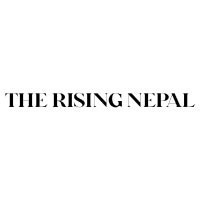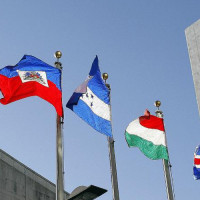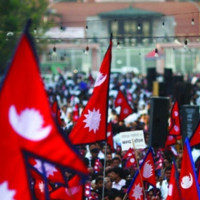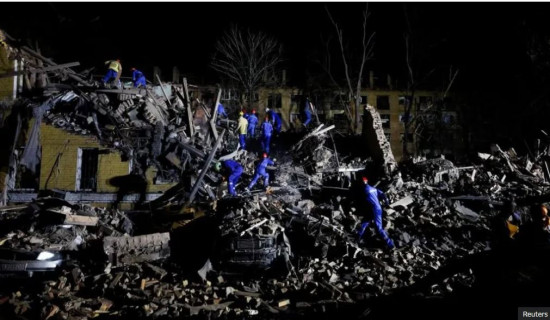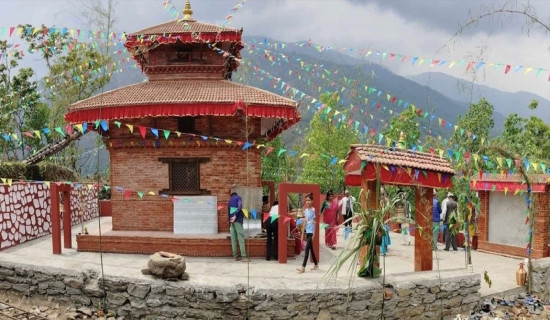- Thursday, 24 April 2025
Deserted Myanglung: A tale of fading town
By Thakur Senehang,Tehrathum, Apr. 24: Myanglung Bazaar, the administrative centre of Tehrathum, a hilly district in Koshi Province, is gradually losing its liveliness.
Following the restructuring of local governance and changes in administrative service delivery, the once-busy town has grown increasingly deserted.
With the implementation of federal governance in Nepal, the government adopted a system of rural and urban municipalities across the country to bring administrative services, development, planning, and resources directly to the people through local units. Myanglung is one of the areas visibly impacted by this shift. Previously a vibrant town, Myanglung attracted people from outside the district for official work, judicial services, healthcare, education, and business.
Hotels, transportation services, retail shops, and other service sectors thrived on this footfall. Now those scenes have all but disappeared.
Impact of decentralisation
As local governments gain strength, essential services have become available at the ward and municipal level.
Previously, citizens had to travel to the district headquarters for basic documentation like citizenship, birth, and death certificates, and caste verification. Today, these services are accessible within their local municipalities, reducing the need to travel to Myanglung—and with that, the town’s daily activity has noticeably declined.
Padma Limbu, a shopkeeper in Myanglung, says, “We invested in our shops when business was good. Now, we spend entire days waiting for customers who never come.” Traders lament that hundreds of people once visited the town daily for services, but declining footfall has severely impacted business.
Collapse of hospitality and transport
Kedar Bhagat Pradhanang, a long-time hotel entrepreneur, recalls, “There was a time when our hotel would be full two to three days a week. Now, the rooms remain vacant for months. Even the number of tourists has declined.”
With most services now decentralised to the rural and urban municipalities, Myanglung’s crowd has thinned dramatically.
The transport sector has suffered equally. Drivers operating routes from Myanglung to neighbouring municipalities report running half-empty vehicles.
“There are hardly any passengers,” says Rabindra Rai, who drives on the Hile and Laligurans routes. “Sometimes, the fare doesn’t even cover fuel costs.” Previously packed vehicles now leave with empty seats, a constant concern for transport entrepreneurs.
Youth exodus and market isolation
A large number of local youths have migrated abroad in search of employment. Those who remain often move to cities like Dharan, Itahari, Biratnagar, or Kathmandu due to lack of opportunities. This outmigration has significantly affected the socio-economic dynamics of Myanglung.
Government institutions and development prospects
Some key offices—such as the District Administration Office, District Police Office, Court, Land Survey, and Land Revenue Offices—still operate from Myanglung. However, even these institutions report a noticeable drop in visitors.
As education, healthcare, and private sector services expand into local municipalities, Myanglung’s central importance is steadily diminishing. Although it remains the district headquarters, its fading liveliness has become a matter of concern.
Without stable and future-oriented plans, the market’s existence itself may come under threat. As development agendas shift away from
Myanglung, doubts are growing over its long-term future. Local intellectual Bipin Nidolek says, “Myanglung needs to be reimagined with new creative,
cultural, and tourism-focused initiatives. Only then can its vibrancy be restored.”
The mayor’s initiatives
To preserve the historical legacy of Myanglung, the Mayor of Myanglung Municipality, Sanjay Kumar
Tumbahangphe, claims to be taking active steps. “We are prioritising industry, agriculture, tourism, and infrastructure,” he said.
The municipality has proposed initiatives including support for local agriculture and handicrafts, youth entrepreneurship, preservation of historical sites, and the construction of a bridge over the Tamor River.
The way forward
Promoting tourism: Nearby natural and cultural heritage sites could be developed to attract visitors.
Educational infrastructure: Establishing higher education centres could encourage youth to stay and study locally.
Leveraging communication and technology: Transforming Myanglung into a digital service hub could unleash new possibilities.
While the strengthening of local governance is a positive step, preserving the identity of long-established market centres like Myanglung requires long-term planning.
Myanglung is now at a crossroads—not just a story of one fading market, but a broader narrative of a
district slowly losing its central identity. If timely and coordinated strategies are not adopted by local and
federal bodies, the once-thriving Myanglung Bazaar may soon exist only in memory.


